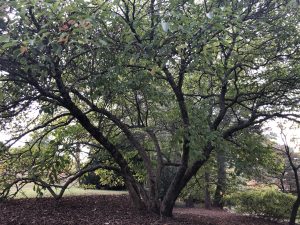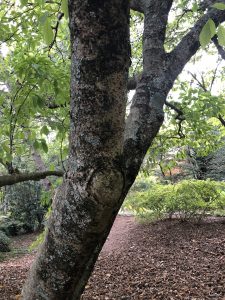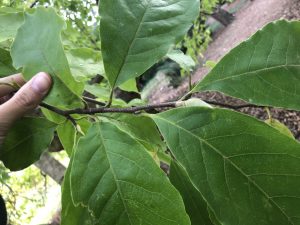Sit Spot #3 Blog

subject
Arrival time: 4:32 Departure: 5:29 Total stay: Approx. 1 hour
Remember that tree that is immediately facing me in my sit spot? The one with 6 main branches growing from the ground as one tree? It’s been bugging me that I haven’t been able to figure out what it was, especially since I was able to identify the oak and catalpa tree I also sit by. This tree is supposed to be one of the three things I monitor!

lichen and bark close-up
As you can see, the tree’s main branches are widely spread out, some of which curve towards the sky while others almost touch the ground. There are interesting ridges that look like gaps in the tree’s bark, and lichen and other fungal matter lines some of the tree bark as well. The bark itself is still very light compared to other trees’ dark brown, and there are occasional large knots you’ll find along the tree’s joints. Some of the sub-branches grow at crooked angles, and others are completely straight. As you look up into the tree’s canopy, it seems as though all the little branches form a complex web. It is not dense enough that you can’t see the sky behind it. The leaves are light green, and they sit in alternating patterns on their tree branches – they do not sit immediately opposite one another, they are staggered. If you look closely, you can see there are large buds with a hairy outer layer, with smaller buds seen on most leaves.
I had spent hours trying to identify what kind of tree this is, popping it into different identification sites and tables and coming up empty, but after I spoke to Liz about it we decided that it was most likely a type of magnolia. She also let me know that this tree was not a native species. According to Arbor Day Foundation, magnolias are very unique and may be one of the oldest in their flowering plant families. Once they bloom, their flowers can be pink, purple, white, or yellow. These trees have a light-colored bark and are usually found in evergreen varieties (though deciduous is not uncommon), so they keep their green leaves all year round. It will be easier to identify a specific type of magnolia later in the year, after I determine if this tree is keeping its leaves through winter or dropping them.


There are many kinds of magnolias that are not native to America, and there are many kinds that are both evergreen and deciduous. To truly identify this species, I’ll need to wait this tree out. I just wish I was still doing this project in the spring so I can see what flowers it blooms and let you all know! But anyhow, this experience was very stressful. I really did enjoy identifying the other trees in my area, particularly because I took a sense of pride in how easy it was to finally figure out what they were! But not this one – the tree I chose for this assignment. I’m still unpleased that I don’t have an exact species of magnolia, and it was an incredible challenge even getting this far. When I think of magnolia, I think of them in full bloom which is part of the reason why I was in such disbelief that this tree fits into that category, I believe. On the other hand, though, I did love getting to observe it closely and I took pleasure in writing down those observations in detail, as well as sketching out the tree and several subparts of it.
See you guys next time,
Emily


It is good you finally managed to narrow it down and don’t worry, you will soon find out what it is. It is definitely an interesting tree and sort of relaxing to observe. I love this kinds of spread out trees.
I hope you find out what it is! Seems like a very cool sit spot!